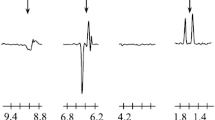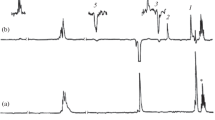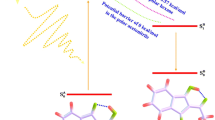Abstract
Chemically Induced Dynamic Nuclear Polarization (CIDNP) technique is applied to study the photochemical reactions of 1-acetylindole-2,3-dione (AID) with several hydrogen donors (1–13). These reactions take place by direct hydrogen abstraction of triplet excited AID from the corresponding 1–13 to give neutral radical pair intermediates, which afford polarized starting materials by back hydrogen transfer and give polarized coupling products by radical pair recombination.
Similar content being viewed by others
References
Salikhov, K. M., Molin, Yu. N., Sagdeev, R. Z. et al., Spin Polarization and Magnetic Effects in Radical Reactions, Elsevier: Amsterdam, 1984.
Bonnett, R., Photosensitizers of the prophyrin and phthalocyanine series for photodynamic therapy, Chem. Soc. Rev., 1995, 24 (1): 19–33.
Bieck, P. R., Antomin, K. H., Schulz, R., Monoamina Oxidose, Netherlands: Utrecht, 1993,177–196.
Haucke, G., Seidel, B., Graness, A., The photochemistry of isatin, J. Photochem., 1987, 37: 139–146.
Zhang, Y., Wang, L., Zhu, Y. et. al., Mechanism of photoinduced reactions between 1-acetylisatin and aldehydes, Eur. J. Org. Chem., 2004(3): 527–534.
Silva, M. T., Netto-ferreira, J. C., Laser flash photolysis study of the photochemistry of isatin and N-methylisatin, Journal of Photochemistry and Photobiology A: Chemistry, 2004, 162: 225–229.
Xue, J., Zhang, Y., Wang, X. L. et al., Photoinduced reactions of 1-acetylisatin with phenylacetylenes, Organic Letters, 2000, 17: 2583–2586.
Arizawa, T., Sakata, T., Itoh, S. et. al., The effect of the coulomb force on the diffusional motion of radicals as studied by the solvent permittivity dependence of the CIDNP intensity, Chem. Phys. Lett., 1992,195: 16–20.
Goez, M., Frisch, I., Phtocycloadditions of quinones with quadricyclane and norbornadiene: a mechanistic study, J. Am. Chem. Soc., 1995, 42: 10486–10502.
Adrian, F. J., Chemically Induced Magnetic Polarization, Dordrecht, Holland: Reidel, 1977, Ch. 5.
Kaptein, R. J., Simple rules for chemically induced dynamic nuclear polarization, Chem. Soc., Chem., Commun., 1971, 732–733.
Dixon, W. T., Murphy, D., The electron spin resonance spectra of alkyl ether radical cations, J. Chem. Soc., Perkin Trans. 2, 1976, 1823–1828.
Weller, A., Photoinduced electron transfer in solution: exciplex and radical ion pair formation free enthalpies and the solvent dependence, Z. Phys. Chem. (Wiesbaden), 1982, 133 (1): 93–98.
Author information
Authors and Affiliations
Corresponding author
Rights and permissions
About this article
Cite this article
Guo, H., Yan, B., Wang, X. et al. CIDNP study of the photochemistry of 1-acetylindole-2,3-dione. Sc. China Ser. B-Chem. 48, 115–121 (2005). https://doi.org/10.1360/04yb0060
Received:
Issue Date:
DOI: https://doi.org/10.1360/04yb0060




